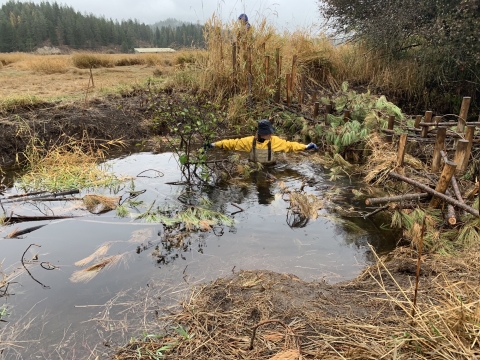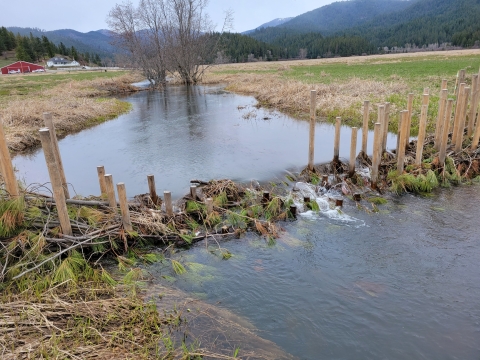“One plus one plus one equals six on this project,” said Kat Hall, restoration manager for The Lands Council, an environmental non-profit organization that seeks to preserve and restore Northwest ecosystems through partnerships.
The excitement is evident in Hall’s voice as she speaks about an innovative and collaborative effort to reconnect and restore aquatic habitat in Thompson Creek, a primary tributary to Newman Lake located northeast of Spokane, Washington. For the past 3 years, Hall has been part of what she calls “a dream team” of federal, state, and local partners to design, implement, and monitor beaver dam analogs (BDAs), human made structures inspired by nature’s busiest builder that efficiently improve the health of aquatic ecosystems.
Historically, Thompson Creek meandered through the lower watershed; but over a century ago, it was straightened to accommodate for agriculture, helping to reduce flooding for farmers. While the straightened channel was beneficial to the farmers, it had less desirable impacts on watershed health. The straighter, less natural flow path increased the speed of the water, led to the erosion of the bank, and transported more sediment and pollutants downstream into Newman Lake. This incision of the creek has also caused a disconnection between the creek and its surrounding floodplains, which has allowed for the dominance of reed canarygrass in the area, a non-native species that outcompetes more diverse and beneficial vegetation.
“One of the primary concerns about straightening the channel and disconnecting it from its floodplain is the increased phosphorous levels we are seeing as a result,” explained Brian Walker, a private lands biologist with the U.S. Fish and Wildlife Service (Service). “Phosphorous travels with the sediment through Thompson Creek and ends up downstream in Newman Lake, which really impacts the water quality in the lake.”
While phosphorus is a naturally occurring and essential nutrient for plants and animals, too much of it can cause explosive growth of aquatic plants and algae. This can lead to a variety of water quality problems, including low dissolved oxygen concentrations, which can cause fish kills and harm other aquatic life. The major concern with phosphorus in Newman Lake is a toxic blue-green algae bloom that can cause the lake to be closed to recreation and private landowners (see a write-up from USGS on phosphorous and water quality).
“High levels of phosphorous are detrimental to both people and wildlife — just a couple licks of contaminated water can be lethal for pets; it’s pretty bad stuff,” said Walker. “But thankfully, we people are learning how to mimic wildlife to come up with a solution for us all!”
Based at Turnbull National Wildlife Refuge in northeastern Washington, Walker works for the Service’s Partners for Fish and Wildlife Program, an innovative program that engages private landowners, local organizations, Tribes, and other stakeholders in collaborative conservation.
“Thompson Creek is really a shining example of what the Partners for Fish and Wildlife Program does — we bring local people and agencies together that have a shared interest in restoring a place like Newman Lake and ensure the on-the-ground work gets done in a scientifically rigorous and environmentally sound way,” said Walker.
According to the Washington State Department of Ecology, Thompson Creek contributes to 43% of the total phosphorous in Newman Lake, making it a logical target for reduction efforts.
“Since so much of the lake’s water quality issues arise from Thompson Creek, we get a lot of bang for our buck by focusing on improving the health of that specific waterway,” said Walker.
Improving Thompson Creek has long been a goal, and several time consuming and costly measures have been implemented in the past with varying degrees of success.
“We weren’t getting the results we hoped for from other projects and we needed to go in a different direction; we needed to get creative,” said Walker.
Inspiration struck in the form of brown fur and bucked teeth — beavers. Like ecosystem engineers, beavers manipulate their environment by building dams that slow the passage of water through a river and can act as a natural filter that cleans the water supply. Beaver dam analogs aim to do the same thing through creating roughness — think speed bumps — to slow water velocity and allow sediment and pollutants to settle. The beaver dam analogs will also raise the water level of Thompson Creek, reconnecting it to its floodplain and allowing for the growth of more natural vegetation to create a healthier ecosystem.
“The Partners for Fish and Wildlife Program has had success with at least 20 BDAs in other Washington watersheds and, with the help of our ʻdream team,’ we knew our odds of making positive change in Thompson Creek were high,” Walker said.
The “dream team,” compromised of partners from every level — The Lands Council, Partners for Fish & Wildlife Program at Turnbull National Wildlife Refuge, Gonzaga University, Spokane Conservation District, Newman Lake Property Owners Association, and Spokane County — got to work in 2019 and began making the beaver dam analogs in Thompson Creek a reality.
In addition to this collaboration among agencies and organizations, local people also played an essential role in the beaver dam analog project.
“The on-the-ground part of this project would not have been possible if not for volunteers and students in the community who helped us weave the materials together to create the structures,” said Hall, “It’s been a really inspiring project from start to finish.”
Before this on-the-ground work began, a senior design team of Gonzaga civil engineering students led by professor of civil engineering Dr. Sue Niezgoda got to work in the classroom, conducting an extensive literature review and evaluation of the existing watershed. From there, the students developed a beaver dam analog design that mitigates some of the water quality issues in Thompson Creek.
“I love working on these collaborative BDA projects — especially with Brian and Kat — because they are fairly small scale and have a big impact,” said Niezgoda. “Thompson Creek is the biggest project we have worked on, and it is a great opportunity for my civil engineering undergraduate students to sink their teeth into a real project — it teaches them how to apply their water resources knowledge to design and literally get their feet wet.”
After the design phase comes what Niezgoda calls “the fun part” — implementation. Hall describes this step as “people, posts, plants, and paperwork”, and her job is to bring together students, landowners, and other volunteers to install the BDA structures.
Implementation of the BDA complex occurs in two phases:
Phase one begins when staff from The Lands Council and the Partners for Fish and Wildlife program spend about a week pounding BDA posts as the “framework” of the structures. Using equipment from Turnbull National Wildlife Refuge, the team pounds 10-foot posts about 5 feet into the stream bed. Each BDA can be 40 to 80 posts depending on location and type.
From there, phase two is comprised of collecting all the weave material — small pine and fir saplings — and getting it on site. This material is then woven into and through the beaver dam analog posts to create a permeable structure structure
Something temporarily or permanently constructed, built, or placed; and constructed of natural or manufactured parts including, but not limited to, a building, shed, cabin, porch, bridge, walkway, stair steps, sign, landing, platform, dock, rack, fence, telecommunication device, antennae, fish cleaning table, satellite dish/mount, or well head.
Learn more about structure that will slow water flow and copy the ingenious work that beavers do when they bring wood into the water to construct their dams.
“Think underwater basket weaving,” said Walker. “Not only do we get the chance to be creative on this project, we are really exercising excellent environmental sustainability.”
In an impressive example of reduce, reuse, recycle, the material sourced for the 18 beaver dam analogs on the Thompson Creek project used pine saplings from 5 acres of thinning done by a private landowner. Now, material that would have otherwise been burned or chipped, acts as both weave for the BDAs and additional carbon storage, further enhancing ecosystem health. So far, the team has installed 18 BDA structures and has plans to install an additional 13 structures after the floodplains are reactivated.
With implementation complete, Gonzaga University students and faculty have spent the last year monitoring the BDA complex’s ability to retain water, sediment, and phosphorous using drone captured aerial imagery, on-the-ground field surveys, and water quality testing. Now, after one full year of monitoring, the first results are in.
“The initial results are very promising for this project,” said Walker.
“Our monitoring results are showing that the BDAs are inducing ponding and channel widening, which over time will reduce stream energy and allow for sediment and phosphorus retention within the creek,” added Niezgoda.
Hall and Niezgoda are equally optimistic about the future of the BDA projects at Thompson Creek.
“Like all good things, it takes time and patience to fully realize the benefit; but based on what we have seen so far and other BDAs we’ve worked on, we are definitely on the right track,” said Hall.
“We have already been able to create improved habitat as evidenced by an increase of diverse macroinvertebrates. Water connects us all, and those little guys are big indicators for watershed health; so if they are healthier, so are we,” said Niezgoda. “Leave it to beavers to inspire productive and powerful change!”
_________________________________________________________________
Beaver dam analogs are making headlines: Check out this news story in the Spokesman Review






